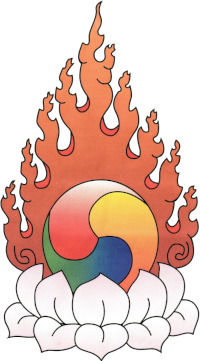Here we are going to utilize Green Tara as our base and the information that you are going to learn is about Green Tara’s ‘little’ activities. I will use a Tibetan text called dröl ma kar ngön gi thö pa dang sung je sum so. That’s dröl ma kar mo dang ngön po. It’s very funny that the color green is often referred to as blue in Tibetan. It’s not that Tibetans are color-blind, but all the green traffic lights are called blue lights. In English, is it a green light or blue lights when you are driving? You say red, yellow, and green lights, right? Many times I say, blue lights, because of the culture that made me. I don’t think I’m color-blind either.
Tara is a very well-known female buddha with her own history and so on, but, in particular, Tara is a yidam. Some people refer to her as a ‘deity’ some refer to her by her name or whatever, but she is a yidam, which means mental commitment. It’s not only that you make the commitment: it is from both sides. From our angle, we make one; from their angle, from the wisdom-original point-of-view there is also one. The meeting of that commitment coming from the other side with that we have made becomes the individual mental commitment. That is really what a yidam is.
I have not taught normal, usual Green Tara before. I have taught on White Tara so many times, and also on Chittamani Tara, which is a little more secret, but very important. Green Tara’s practice is very common, and, traditionally for many people has been almost like worshipping. Here we will try to make Green Tara our subject and try to build a relationship with her. We will try to give you something to think about, something for you to pray, and something for you to do by yourself. Prayer is one thing, requesting is one thing, and another thing is utilizing that by yourself by doing something.
That is the quality, the beauty of Vajrayana. Whether you like it or not, this is Vajrayana. The quality and beauty of Vajrayana is not only simply wishing and relying, but the individual practitioner personally moving and doing something. Saying and praying is the easiest first step, but also we can think a little deeper, with a little more usage. That’s what we want to follow here.
~ Gelek Rimpoche, Chapter 2, 2013 Green Tara Teachings, Garrison, NY


